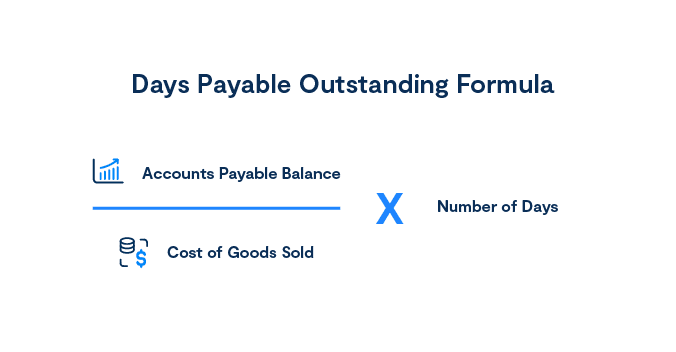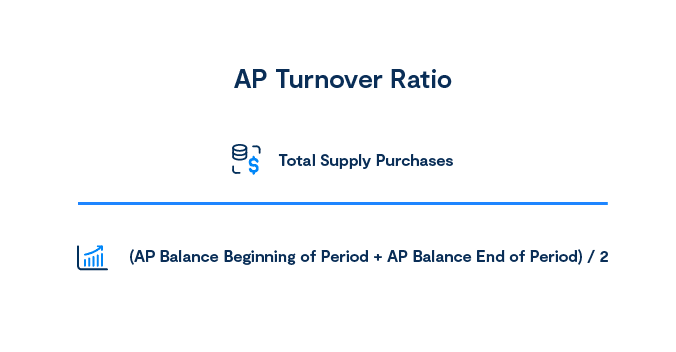Monitoring and reporting on key performance indicators (KPIs) is an important exercise in any department. You may be wondering what types of accounts payable metrics your team can watch to help ensure your AP processes are efficient and consistently improving. This article will share 15 AP metrics that will help contribute to the overall success of your team, fostering a performance-oriented culture.
1. Days Payable Outstanding Formula
The days payable outstanding formula is calculated with a simple equation:
• Find the company’s accounts payable balance for a given period
• Divide that by the cost of goods sold in that period
• Multiply that by the number of days in that period
• The result is days payable outstanding (DPO)

The days payable outstanding formula measures the average number of days it takes a company to pay its invoices. Using the DPO formula can offer a way to measure AP efficiency and working capital management.
A higher result from the days payable outstanding formula may indicate better cash flow. But that may result in strained supplier relationships, as these businesses wait for payment.
2. AP Turnover Ratio
AP turnover ratio is calculated by:
• Find the total supply purchases for a given time.
• Add the AP balance at the beginning of the same period to the AP balance at the end. Divide that by two. That number will be the average AP balance.
• Divide the total supply purchases number by the average AP balance number.
• The result is AP turnover ratio.

AP turnover ratio measures the frequency at which a company pays off its AP balance. A high AP turnover ratio may indicate a company is in financial distress and experiencing difficulty paying its suppliers. A low AP turnover ratio may signify that a company is not effectively reinvesting profits.
3. Number of Invoices Received
This is a straightforward measurement that serves a foundational KPI for contextualizing other AP metrics. Number of invoices received is simply a count of the volume of invoices your company processes in a set period, typically a month or quarter. This is also known as invoice volume.
4. Invoice Processing Cycle Time
Invoice processing cycle time tracks the average time your AP department takes to process an invoice from receipt through issuing payment. To understand invoice processing time, count the number of days (including weekends) it takes your team to process each invoice and average the totals.
A lower invoice processing cycle time indicates process efficiency. A higher invoice processing cycle time may suggest bottlenecks in your process.
5. Invoice Approval Time
Invoice approval time measures the time it takes for your organization to approve an invoice. To calculate invoice approval time, count the number of days the approval process takes for each invoice, beginning to end. Then average the totals.
Reduced invoice approval time can lead to faster invoice processing, which helps minimize the risk of late fees and damaged supplier relationships.
6. Payment Cycle Time
Payment cycle time measures the time it takes your AP department to issue a payment once an invoice is approved. To calculate payment cycle time, count the days between when each invoice is approved and the payment is issued. Average these totals to derive payment cycle time.
A short payment cycle time is important to help ensure timely payments and avoid potential late fees.
7. Invoice Accuracy Rate
Invoice accuracy rate is the percentage of invoices processed without errors. Examples of errors include duplicate invoices, data entry mistakes, and incorrect PO numbers.
To calculate invoice accuracy rate:
• Divide the number of invoices processed without errors by the total number of invoices processed.
• Multiply the result by 100.
• The resulting figure is your team’s invoice accuracy rate.
Invoice accuracy rate is an important part of accounts payable metrics because it helps improve payment accuracy and reduces the re-work required to fix mistakes. An invoice accuracy rate of 100% is ideal.
8. Number of Late Payments
The number of late payments is what it sounds like – a count of the quantity of payments that your organization issued when they were past due. Tracking late payments is a valuable part of AP metrics, as it helps set a benchmark to improve payment speed, reduce late payment penalties, and improve supplier relationships.
9. Supplier Payment Terms
Supplier payment terms measure the average number of days suppliers grant for payment. By analyzing payment terms, AP teams can identify opportunities for negotiating better terms or taking advantage of early payment discounts, ultimately reducing costs.
10. Processing Cost
There isn’t a standard accounts payable metrics formula for computing your processing cost per invoice. Depending on your organization, this can include a number of elements, like:
• Labor costs (salaries of staff who process invoices)
• Technology costs (AP software licenses)
• Operational costs (supplies like paper and postage)
To calculate your processing cost per invoice, add up your costs for a certain period and divide it by the invoice volume for that time period.
Decreasing processing costs is a common goal for many AP departments.
11. Supplier Turnover
Supplier turnover refers to the percentage of suppliers lost or gained within a specific period. Measuring supplier turnover assists in assessing the stability and reliability of the supply chain, helping ensure consistent product quality and availability.
Understanding supplier turnover rates aids in strategic planning, risk management, and cost control by identifying potential supply chain disruptions. High supplier turnover may indicate issues such as poor supplier relationship management, prompting the need for evaluation and improvement.
12. Discount Realization Rate
Discount realization rate assesses the percentage of invoices paid early to capture supplier discounts. The accounts payable metric measures cost savings and cash flow management.
A high discount realization rate shows that your AP team is maximizing discount potential, contributing to cutting costs. A low discount realization rate suggests that if your team added efficiencies, it could help positively impact the bottom line.
13. Compliance Rate
Compliance rate is the percentage of invoices that meet internal policies and regulations. Measuring this helps ensure compliance with accounting standards and potentially reduces risk.
While organizations aim for a 100% compliance rate, this might not be possible if regulations are complex and change often.
14. AP Automation Level
AP automation level refers to the percentage of invoices your AP team processes electronically. This measures automation adoption and its impact on efficiency and accuracy.
By evaluating AP automation, businesses can benchmark performance, drive continuous improvement, and make sure they’re leveraging technology investments to the fullest. High automation levels typically result in cost savings thanks to decreased labor expenses and early payment discounts.
15. Percentage Touchless Invoice Processing
This accounts payable performance metric assesses the proportion of invoices your AP team processes without manual intervention. A higher touchless invoice processing percentage indicates efficient straight-through processing, which suggests your automation is working well and reducing your team’s manual efforts.
To monitor this, you can create a report that lists invoices that went to an exception queue. Divide the number of invoices on that list by the total number of invoices to arrive at a touchless invoice percentage.
Accounts Payable Metrics: The Benefits
Monitoring accounts payable metrics and KPIs delivers numerous advantages. It helps ensure operational efficiency, cost-effectiveness, accuracy, compliance, and strategic growth. Additionally, monitoring AP metrics helps teams promptly identify and address issues like bottlenecks.
Following are several benefits organizations may experience by putting accounts payable metrics in place.
Optimized Processes
AP metrics such as invoice processing time and payment cycle time can help teams identify process chokepoints and areas for improvement.
Improved Productivity
Monitoring accounts payable metrics aids in assessing performance and identifying training needs. Teams can use accounts payable KPIs to design performance-based incentive programs, motivating employees to achieve higher efficiency and accuracy.
Better Resource Allocation
Monitoring the number of invoices in the queue and the speed at which they’re processed helps teams distribute workload and identify situations when additional resources (whether talent or technology) may be necessary to prevent overwork and enhance team productivity.
Reduced Errors
Tracking error rates and exceptions allows teams to identify common mistakes and implement corrective measures.
Enhanced Expense Tracking
AP KPIs related to cost per invoice and early payment discounts help teams identify opportunities to reduce costs and more effectively manage expenses.
Risk Prevention
Tracking accounts payable metrics like duplicate payments and error rates can help teams identify potentially fraudulent activities and take prompt corrective action. Additionally, tracking metrics related to late payments and discount rates can help the AP department minimize financial losses.
Healthier Supplier Relations
AP metrics such as late payment rate and payment cycle time help maintain good relationships with suppliers by ensuring timely payments.
In summary, tracking accounts payable benchmarks and metrics like days payable outstanding formula and AP turnover ratio helps promote operational efficiency, reduced fraud, timely payments, and fewer errors. It can also help your team use its technology tools to their potential, optimizing those organizational investments.
To learn more about using tools like AvidAnalytics to track accounts payable performance metrics, click below to speak with one of our automation experts.


